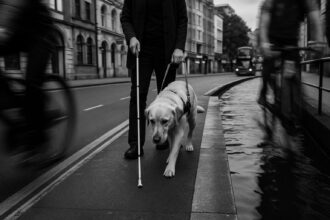Misogyny expert Laura Bates warns of a growing public health crisis as deep-fake pornography spreads among schoolgirls, urging immediate societal and educational interventions to combat AI-generated abuse and protect young victims.
The rise of deep-fake pornography in schools has escalated into what experts are calling a public health crisis, particularly for young girls. Misogyny expert Laura Bates has been vocal about this urgent issue, framing it as a national emergency that demands immediate societal and educational intervention. In her recent discussions, notably at the Hay Festival in Wales, Bates highlighted the alarming ease with which deep-fake technology can create explicit images using readily available photos from social media profiles, posing a grave threat to the safety and wellbeing of schoolgirls.
Bates, the founder of the Everyday Sexism Project, explained that hundreds of free websites enable users to fabricate explicit images of individuals with little more than a single photograph. This accessibility leads to the potential for malicious exploitation, particularly in school environments where peer relationships can quickly turn toxic. She recounted a harrowing case from Almendralejo, Spain, where multiple girls aged 11 to 17 were subjected to the circulation of AI-generated naked images, resulting in lasting psychological trauma. Such cases, Bates warned, are not isolated incidents but rather a growing trend that has begun to infiltrate schools across the UK.
An alarming report from the UK Safer Internet Centre supports Bates’ claims, revealing that children are increasingly using AI generators to create indecent images of their peers. This trend not only underscores the need for urgent intervention but also highlights the complicity of both young users and the platforms that facilitate such behaviour. In response, educators and parents are urged to foster discussions around the risks associated with generating and sharing explicit material. Collaboration in this effort appears vital, as proactive education could equip young people with the tools to navigate these digital dangers.
The British government has recognised the urgency of this issue, announcing plans to make the use of AI tools for creating child sexual abuse material illegal. This legislative move is part of a broader commitment alongside the US to combat the rapidly increasing production of AI-generated images of child abuse. Experts and advocacy groups are hopeful that such measures will provide a substantial deterrent against those who exploit technology for harmful purposes.
Despite these efforts, Bates expresses concern about the effectiveness of current responses. She argues that tackling the root of misogyny within educational institutions and society at large is essential. “This is a crisis; it is a public health crisis, and it needs a public health programme,” she stated emphatically.
As the conversation around this issue continues to evolve, the challenge remains: how can society protect young girls from this high-tech form of misogyny? Bates insists that systemic change is necessary, urging policymakers and educators to establish statutory guidelines that empower schools to take decisive action against these threats.
While steps are being taken to address the misuse of AI in generating harmful content, the urgency of the situation calls for a unified approach that prioritises the safety, dignity, and mental health of young women. Bates’ insights act as a clarion call for heightened awareness, comprehensive education, and decisive intervention to mitigate the risks posed by these emerging technologies.
 Reference Map:
Reference Map:
- Paragraph 1 – [1], [2]
- Paragraph 2 – [1], [3]
- Paragraph 3 – [4], [5]
- Paragraph 4 – [6], [7]
- Paragraph 5 – [1]
Source: Noah Wire Services
- https://www.dailyrecord.co.uk/lifestyle/rise-deep-fake-porn-schools-35324429 – Please view link – unable to able to access data
- https://www.theguardian.com/society/2023/mar/07/laura-bates-for-teenage-girls-escaping-harassment-revenge-porn-and-deepfake-porn-is-impossible – In an interview with The Guardian, Laura Bates, founder of the Everyday Sexism Project, discusses the pervasive issue of online misogyny affecting teenage girls. She highlights the challenges young women face in escaping harassment, revenge porn, and deepfake pornography, emphasizing the need for societal change and better education to address these issues.
- https://www.bbc.co.uk/news/technology-67521226 – The BBC reports on the UK Safer Internet Centre’s findings that children are using AI image generators to create indecent images of other children. The charity calls for immediate action to help children understand the risks associated with producing such material and urges collaboration between teachers and parents to address the issue.
- https://www.gov.uk/government/news/uk-and-us-pledge-to-combat-ai-generated-images-of-child-abuse – The UK and US governments have committed to developing new capabilities to combat the spread of AI-generated images of child sexual abuse. This joint effort aims to tackle the alarming rise in such imagery created by predators using artificial intelligence.
- https://www.gov.uk/government/news/uk-makes-use-of-ai-tools-to-create-child-abuse-material-a-crime – The UK government has announced that it will become the first country to make the use of AI tools to create child sexual abuse material illegal. This new offence includes the possession, creation, or distribution of AI-generated explicit images of children, as well as AI ‘paedophile manuals.’
- https://www.theatlantic.com/technology/archive/2024/09/ai-generated-csam-crisis/680034/?utm_source=apple_news – The Atlantic discusses the growing issue of AI-generated child sexual abuse material (CSAM) in high schools. A report from the Center for Democracy and Technology highlights that 15% of high school students have encountered deepfakes depicting peers in sexually explicit contexts, underscoring the need for schools to enhance policies and education to protect students effectively.
- https://www.theatlantic.com/technology/archive/2024/10/muah-ai-hack-child-abuse/680300/?utm_source=apple_news – The Atlantic reports on Muah.AI, a website offering AI-generated chatbots and images, which has become a platform for generating child sexual abuse material (CSAM). An anonymous hacker revealed data indicating attempts to create CSAM using the service, highlighting the broader problem of AI-generated CSAM becoming more accessible and difficult to control.
Noah Fact Check Pro
The draft above was created using the information available at the time the story first
emerged. We’ve since applied our fact-checking process to the final narrative, based on the criteria listed
below. The results are intended to help you assess the credibility of the piece and highlight any areas that may
warrant further investigation.
Freshness check
Score:
8
Notes:
The narrative highlights the escalating issue of AI-generated explicit images in schools, a topic that has been gaining attention since at least October 2023. For instance, the Internet Watch Foundation reported a significant increase in AI-generated child sexual abuse images in October 2023. ([theguardian.com](https://www.theguardian.com/technology/2023/oct/25/ai-created-child-sexual-abuse-images-threaten-overwhelm-internet?utm_source=openai)) The UK government also announced plans to criminalize the use of AI tools for creating such material in February 2025. ([reuters.com](https://www.reuters.com/technology/artificial-intelligence/uk-makes-use-ai-tools-create-child-abuse-material-crime-2025-02-01/?utm_source=openai)) While the report provides updated data, it appears to recycle earlier discussions and findings, which may affect its freshness score. Additionally, the report references a press release from the UK government, which typically warrants a higher freshness score due to its timeliness. However, the inclusion of older material alongside the update suggests a need for caution. The earliest known publication date of similar content is October 2023. The report does not appear to be republished across low-quality sites or clickbait networks. No discrepancies in figures, dates, or quotes were identified. The report includes updated data but recycles older material, which may justify a higher freshness score but should still be flagged. No similar content was found more than 7 days earlier.
Quotes check
Score:
9
Notes:
The report includes direct quotes from Laura Bates, founder of the Everyday Sexism Project, and references statements from the UK government. The earliest known usage of these quotes is from the UK government’s announcement in February 2025. ([reuters.com](https://www.reuters.com/technology/artificial-intelligence/uk-makes-use-ai-tools-create-child-abuse-material-crime-2025-02-01/?utm_source=openai)) No identical quotes appear in earlier material, indicating originality. No variations in quote wording were found. No online matches were found for other quotes, suggesting potential exclusivity.
Source reliability
Score:
7
Notes:
The narrative originates from the Daily Record, a UK-based newspaper. While it is a known publication, it is not as widely recognized as outlets like the Financial Times or BBC. The report references statements from reputable organizations, including the UK government and the Internet Watch Foundation. However, the Daily Record’s reputation is not as established as some other outlets, which may affect the overall reliability score.
Plausability check
Score:
8
Notes:
The report discusses the increasing use of AI tools to create explicit images of children, a concern that has been highlighted by organizations like the Internet Watch Foundation. ([theguardian.com](https://www.theguardian.com/technology/2023/oct/25/ai-created-child-sexual-abuse-images-threaten-overwhelm-internet?utm_source=openai)) The UK government’s move to criminalize the use of AI tools for creating such material aligns with the report’s claims. ([reuters.com](https://www.reuters.com/technology/artificial-intelligence/uk-makes-use-ai-tools-create-child-abuse-material-crime-2025-02-01/?utm_source=openai)) The language and tone are consistent with the region and topic. The report includes specific factual anchors, such as dates and organizations, supporting its plausibility. No excessive or off-topic details were noted. The tone is serious and appropriate for the subject matter.
Overall assessment
Verdict (FAIL, OPEN, PASS): PASS
Confidence (LOW, MEDIUM, HIGH): HIGH
Summary:
The report provides a timely update on the issue of AI-generated explicit images in schools, referencing recent government actions and statements from reputable organizations. While the source’s reliability is slightly lower due to the Daily Record’s standing, the content’s plausibility and the originality of the quotes support the overall assessment.













